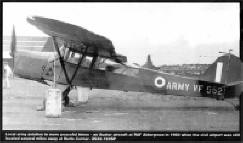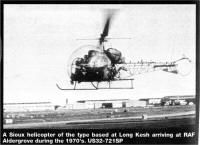
A FLIER'S LIFE RECALLED AT LONG KESH AIR BASE
New book looks at army aircraft around Lisburn
ARMY helicopters and spotter planes have been a familiar sight in the skies over Lisburn for almost 35 years.
Aircraft based at Long Kesh and RAF Aldergrove provided back-up to security forces on the ground during some of the worst years of the troubles.
They were also a familiar sight as they landed at and took off from Thiepval Barracks, the army's headquarters in Northern Ireland.
A new book tells the story of these aircraft for the first time.
'Army Aviation in Ulster' is written by Guy Warner with Alex Boyd.
It begins with a brief history of army aviation dating back to 1878, and looks in more detail at the connection between Northern Ireland and the post World War Two Army Air Corps, covering the period from 1957 to 2004.
However, a large section of the book is devoted to the period of 'the troubles' and traces the development of the use of army aircraft at this time.
The book looks back at technical and tactical changes and many dramatic incidents are covered. There's also an interesting piece about life at Long Kesh during this period. Long Kesh functioned as a helicopter base for much of the 1970's.
The first six Sioux helicopters to be based there were flown from West Germany in early 1972 as the situation in Northern Ireland deteriorated at an alarming rate.
They were transported from Hannover to Aldergrove in two RAF Belfast freighters on February 14 and 15.
Within two hours they were re-assembled and ready to fly to the detachment's new home.
At first sight the base which was located next to the then internment camp appeared to be a 'dismal spot'.
It was described as follows: "Everything seemed to be either half built or half demolished and the whole complex wallowed in a sea of mud. "Unkempt huts and caravans scattered apparently at random and half a draughty hangar peppered with holes."
The squadron's area of operations included a long section of the border - Newry, Forkhill, Crossmaglen and Newtownhamilton,
The main Belfast to Dublin railway line also ran through the area together with many cross border routes both approved and unapproved.
The eastern half of the area included the Mountains of Mourne and a substantial stretch of coastline.
Almost all operational sorties were flown in support of troops on the ground.
The soldiers' commanding officer produced a list of these for his post tour report.
"Recces of border, border incidents, border crossing blocks, suspect cars, areas to select observation posts, areas prior to cordons and searches, buildings prior to 'lifts' of wanted men, suspected booby traps, routes for claymore devices, specific wanted vehicles, hijacked cars and lorries (often burnings), sniper locations, meetings, marches, funerals, public gatherings, recce parties for newly arrived units, Eagle flights with Wessex Casevac, photography of bomb damage, operational planning, border crossing points and public gatherings," he wrote.
"Liason - flying commanders to their scattered sub unit locations, to the scene of incidents and with high priority documents."
This represented the detachment's day time commitment only.
During the hours of darkness a 'Nitesun' aircraft had to be available for call out at minimal notice to illuminate landing sites for helicopters, to light up civil disturbances, night searches for snipers and wanted vehicles, night 'lifts' and on one occasion to search for a ship reported by a Royal Navy minesweeper patrol to be approaching the coast without lights.
At first Long Kesh was used by a mixture of Scout and Sioux helicopters but from 1976 onwards these gave way to a regular rotation of six Scouts and six Gazelles.
A good description of life there during these years was contained in the column 'Bosses Blurb' part of 'Kesh News 658 edition' for winter 1976-1977.
"We're all living in the rather desolate prefab atmosphere of the Maze Prison, just outside the main secure compound," the author wrote.
"There's no point in pretending it's a masterpiece of town planning. The place has grown in a haphazard manner to suit the changing circumstances of the last few years.
"We have a large hanger and very reasonable accommodation and recreation facilities by Northern Ireland standards.
"Our aircraft operate in support of three infantry brigade.
"Their job is to destroy terrorism and restore stability in a large country area stretching right across the southern part of the province.
"Aircraft and crews are detached to security forces' bases up to 35 miles away from The Kesh. "Our aim is to produce the quickest possible reaction time for the ground troops we serve, in providing reconnaissance, deploying troops, moving supplies and evacuating casualties.
"In the most active areas we get a helicopter in the air within three minutes of a request for our help - by day or night.
"None of this would be possible without the hard work and technical skill of our LAD.
"Our nut stranglers work a 24 hour shift on alternate days.
"As always they're proving expert at producing the goods to a high standard in all sorts of situations." However, life at Long Kesh had its lighter moments helped along by the establishment of a menagerie looked after by personnel at the base. At one time this comprised two goats, a brace of ducks, a pair of racing pigeons and eight trout in the static water tank.
These fish were fed with worms caught by a 'patent electrical worming machine' designed by the REME.
A soldier based in Long Kesh recalled: "This device when stuck in the ground and switched on ensured every local worm within a five foot radius suddenly dropped everything and shot to the surface."
'Army Aviation in Ulster' includes many other memories of Long Kesh, Aldergrove and other army aircraft bases in Northern Ireland including Sydenham, which is now the busy Belfast City Airport.
It is published by Colourpoint Books and costs £14.00.
13/08/2004


